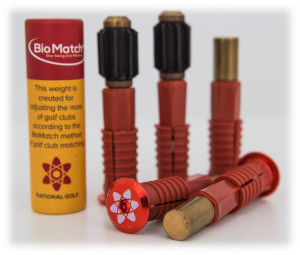 Rational Golf LLC of Florida has signed a distributor agreement with Designer Golf Ltd club fitting studio of the United Kingdom. The contract gives Designer Golf the rights to deliver the revolutionary BioMatch One-Swing Golf Club Matching system directly to its customers. BioMatch will provide more accuracy and distance to all Designer Golf´s club-fitting customers and thereby improve the competitiveness of Designer Golf.
Rational Golf LLC of Florida has signed a distributor agreement with Designer Golf Ltd club fitting studio of the United Kingdom. The contract gives Designer Golf the rights to deliver the revolutionary BioMatch One-Swing Golf Club Matching system directly to its customers. BioMatch will provide more accuracy and distance to all Designer Golf´s club-fitting customers and thereby improve the competitiveness of Designer Golf.
BioMatch offers effortless improvement to any golfer's game by matching the golf clubs within the set and to the body of the golfer. Thereby taking back the accuracy and distance that Swingweight matched golf clubs are robbing you off. The revolutionary system is applied to any golfer´s clubs, old or new.
The online application, available at www.rational-golf.com, creates a model of the golfer swinging each of his or her clubs and thereby determines the optimum weight for each club. The target weight is achieved by adding a specific proprietary weight inside the shaft at the grip end of each club. BioMatch is the last step in the club fitting process.
Once the weights are installed the golfer´s game will improve effortlessly as he or her now only have to ingrain one swing in the subconscious mind. Steering of the club is no longer necessary and is discouraged. The method provides significantly better accuracy and slightly more distance to golfers at all levels. BioMatch is a must have for any golfer who cares about their scores, or even the enjoyment of the game.
 BioMatch replaces the arbitrary Swingweight method of matching golf clubs. The more scientifically inclined golf professionals do understand the problems the outdated Swingweight method creates and are searching for new solutions. One such example is Bryson DeChambeau's single length irons. Entering the properties of the single length irons into the BioMatch algorithm proves that his Irons are matched. BioMatch achieves the advantages of the single length irons without the disadvantages of the single length irons such as reduced accuracy with the “short” irons and lack of distance and height with the “long” Irons. Besides, the other clubs in DeChambeau's set are not matched to his single length irons. BioMatch matches all the clubs in your set. The putter is the only exception. As the putting stroke is a completely different motion, it does not interfere with the subconscious routine of swinging the other clubs.
BioMatch replaces the arbitrary Swingweight method of matching golf clubs. The more scientifically inclined golf professionals do understand the problems the outdated Swingweight method creates and are searching for new solutions. One such example is Bryson DeChambeau's single length irons. Entering the properties of the single length irons into the BioMatch algorithm proves that his Irons are matched. BioMatch achieves the advantages of the single length irons without the disadvantages of the single length irons such as reduced accuracy with the “short” irons and lack of distance and height with the “long” Irons. Besides, the other clubs in DeChambeau's set are not matched to his single length irons. BioMatch matches all the clubs in your set. The putter is the only exception. As the putting stroke is a completely different motion, it does not interfere with the subconscious routine of swinging the other clubs.
 Designer Golf Ltd, located in Daventry just north of London, is now trained and fully equipped to implement the patented BioMatch method to its customers. Steve Low, Managing Director of Designer Golf Ltd, was stunned by the results that BioMatch brought and grabbed the opportunity to become the UK Distributor with both hands: “After applying the method to my clubs I was shocked to see the dispersion, or lack of such, shown on my Flightscope. Designer Golf is now set to revolutionize the club fitting business in the United Kingdom and welcomes customers from all over Europe”.
Designer Golf Ltd, located in Daventry just north of London, is now trained and fully equipped to implement the patented BioMatch method to its customers. Steve Low, Managing Director of Designer Golf Ltd, was stunned by the results that BioMatch brought and grabbed the opportunity to become the UK Distributor with both hands: “After applying the method to my clubs I was shocked to see the dispersion, or lack of such, shown on my Flightscope. Designer Golf is now set to revolutionize the club fitting business in the United Kingdom and welcomes customers from all over Europe”.
The founder of Rational Golf LLC of Florida and inventor of the BioMatch system, Gisle Solhaug, is excited to work with Designer Golf as he will be able to serve golfers in the UK better. The cooperation with Designer Golf will be used as a model for how Rational Golf will appoint and work with distributors worldwide.
Golfers are welcome to learn more at www.rational-golf.com. Club fitters in Europe should contact Steve Low, club fitters outside Europe should get in touch with Gisle Solhaug.
Rational Golf LLC is seeking investors to accelerate growth.